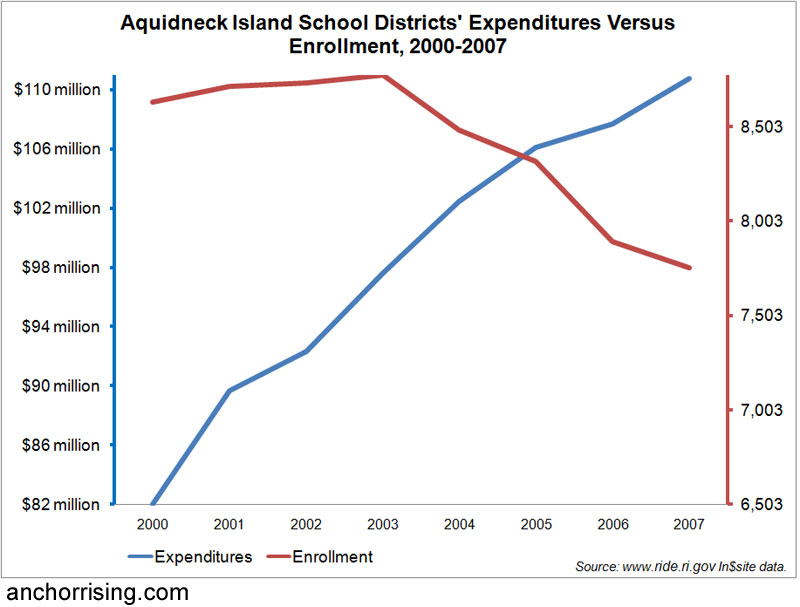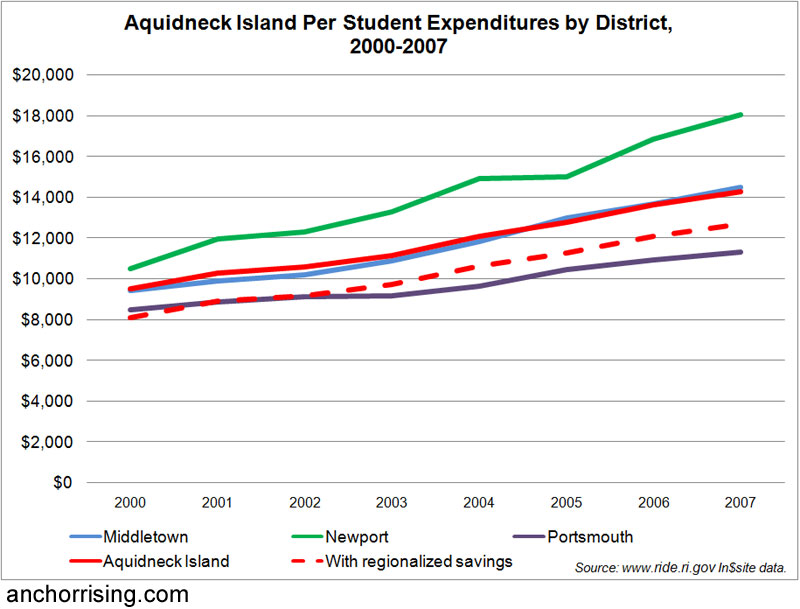Putting School District Mergers into Perspective
Gina Macris reports on a document by the Rhode Island Public Expenditure Council (RIPEC) exploring the financial possibilities of merging the three school districts on Aquidneck Island. Readers may have picked up on the fact that I’m a regionalization skeptic, and Macris’s first paragraph points to the reason:
Declining enrollment and escalating costs mean that Aquidneck Island’s three school districts cannot afford to remain independent and maintain the same quality of education, according to a study by the Rhode Island Public Expenditure Council.
Unless Newport, Middletown, and Portsmouth pool resources and services and consolidate spending to realize economies of scale, the RIPEC study concluded, the districts will become mired in deficit spending over the next several years while seeing the scope of their academic programs curtailed.
Education is only one area in which a sales and marketing campaign is coming together around the notion that regionalization of services is our only hope for financial solvency. Recent experience of local taxpayer groups’ having an increasingly rapid and increasingly potent effect on municipal policies, while at the same time the General Assembly drags its feet and plays procedural games, ought at least to cast a shadow of doubt that consolidating control and (therefore) power is a sensible response to escalating local costs.
In some cases, such as utilities, having a larger contract to offer increases negotiating clout, but in others, such as labor, it narrows the field on which the clout of others (i.e., unions) must be expended. The NEA still receives the same dues, but it needs to influence fewer elected and appointed representatives. With its state and national structure in place, the union will realize efficiencies when it comes to selecting and promoting candidates when there are fewer campaigns to battle; in contrast, concerned residents will face a much more daunting task gaining recognition beyond their immediate communities.
When it comes to operations, yes, there would be fewer “top” jobs, but there would be more lower jobs, each with greater responsibility than before:
The most far-reaching model assumes one central school administration for all the schools on the island. It anticipates the closing of one high school and one middle school but doesn’t designate which ones. Working with the lone superintendent would be two assistant superintendents and one director each for finance, facilities, student services, technology, athletics and academics.
Instead of three superintendents responsible for an average of $37 million and 2,585 students, you get one superintendent and two assistants responsible for $111 million and 7,755. Generally speaking, the savings would seem to be minimal. Of course, closing schools and having the capacity to shuffle around staff (perhaps achieving efficiencies when it comes to teachers who can float from school to school) create savings, but let’s put the numbers into perspective:
RIPEC’s 150-page analysis offers six options for the island’s three districts, from maintaining the status quo to a complete merger. Although not recommending which option the districts should pursue, RIPEC found that making no change could lead to sizable financial problems, and merging services could result in estimated annual savings of $2.8 million to $12.3 million, depending on the degree of consolidation. The savings would begin to be realized in 2012.
Depending how fully the districts regionalize, the savings amount to 2.5% to 11%. Millions of dollars should never be pshawed, but these are hardly game-changing figures, and Rhode Islanders should have zero confidence that bureaucrats and union leaders won’t keep the very same “capacity to pay” numbers in mind as they negotiate and shuffle money around.
In essence, my warning is that we shouldn’t let a fancy new concept distract us from our experience of how Rhode Island actually operates, and the following figures give some representation of that experience. (For the first chart, I laid out the axes to illustrate percentage change, effectively taking the 26% difference between the minimum and maximum for expenditures and showing the same range for enrollment, which varied by about 12%.)


To my eye, combining these three school districts into one, of itself, would buy a few more years before expenditures are right back to their currently problematic mass, and I’m not persuaded that a new paradigm will have been instituted that would change the trajectory or the results.
Folks in business, government, media, and the general population seem to be convincing themselves that consolidation is the clear and obvious way forward. They are correct that some resistance is motivated by narrow parochial preferences, but it would be a risky error to suppose that there aren’t better-informed reasons to object.

Wow, I’m not sure how you only got that out of a 150 page report, or did you only read the projo article.